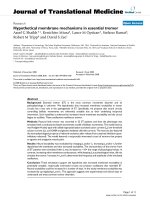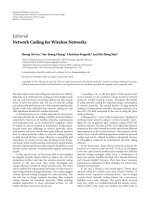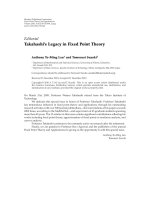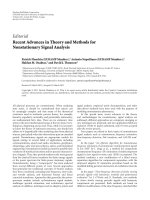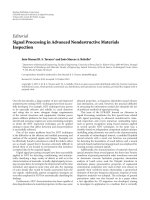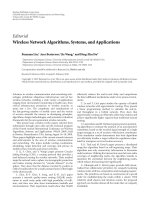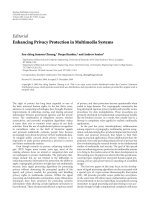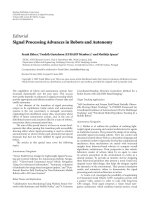Báo cáo hóa học: " Editorial Wireless Access in Vehicular Environmen" pdf
Bạn đang xem bản rút gọn của tài liệu. Xem và tải ngay bản đầy đủ của tài liệu tại đây (420.23 KB, 2 trang )
Hindawi Publishing Corporation
EURASIP Journal on Wireless Communications and Networking
Volume 2009, Article ID 576217, 2 pages
doi:10.1155/2009/576217
Editorial
Wireless Access in Vehicular Environments
Weidong Xiang,
1
Javier Gozalvez,
2
Zhisheng Niu,
3
Onur Altintas,
4
and Eylem Ekici
5
1
University of Michigan, Dearborn, USA
2
University Miguel Hern
´
andez, Spain
3
Tsinghua University, China
4
Toyota InfoTechnology Center Co., Ltd, Tokyo 107-0052, Japan
5
Ohio State University, 205 Dreese Lab., 2015 Neil Ave., Columbus, OH 43210, USA
Correspondence should be addressed to Weidong Xiang,
Received 31 December 2008; Accepted 31 December 2008
Copyright © 2009 Weidong Xiang et al. This is an open access article distributed under the Creative Commons Attribution
License, which permits unrestricted use, distribution, and reproduction in any medium, provided the original work is properly
cited.
Vehicular communications and networks based on the
recent wireless access in vehicular environments (WAVE)
technology comes into sight as a state-of-the-art solution
to Intelligent Transportation Systems (ITS), which is antic-
ipated to be widely applied in the near future to radically
improve the transportation environment in the aspects of
safety, intelligent management, and data exchange services.
WAVE systems will build upon the IEEE 802.11p standard,
which is still active and expected to be ratified in 2009.
WAVE technology is the next generation dedicated short-
range communications (DSRC) technology, which provides
high-speed V2V and V2I data transmission and has major
applications in ITS, vehicle safety services, and Internet
access. Operating at 5.850–5.925 GHz, WAVE systems adopt
orthogonal frequency-division multiplexing (OFDM) and
achieve data rates of 6–27 Mbs/s. In WAVE systems, an RSU
can cover a range of up to 1000 feet.
The fast time-varying and harsh vehicular environment
(doubly selective channel) bring about several fresh research
topics on the study of WAVE systems, which include
mobile channel modeling, the study of Doppler shift, fast
synchronization, quick channel estimate and prediction,
capacity evaluation when adopting multiple-input multiple-
output (MIMO), smart antenna and beamforming, adaptive
modulation, novel network configuration (delay tolerance
networks, DTN), effective media access control (MAC) pro-
tocols, and robust routing and congestion control schemes.
This special issue collects 9 selected papers covering pro-
tocols for real-time safety message delivery, quality of service
(QoS) for video packets, MIMO, space-time coding schemes,
and WAVE system simulator. In addition, two relevant papers
investigating electronic toll collection detection and UWB
vehicular channel are included as well.
Three papers deal with the protocols for real-time safety
message delivery in a vehicular environment for safety
enhancement. In “A rule-based data transfer protocol for
on-demand data exchange in vehicular environment,” H.
Liao and W. Liao proposed a rule-based transfer protocol
upon the so-called request-forward-reply mechanism for
enhancing driving safety and efficiency under the situations
of occluded view and traffic jam, which is thereafter val-
idated by supportive simulations. Meanwhile in “Formal
analysis on performance and reliability of DSRC vehicular
safety communication,” Ma, Chen, and Refai studied the
performance of safety message broadcasting in the context of
message priorities and arrival, hidden nodes, fading channel,
andwirelesscoverageaswellasvehiclemobility.Analytic
formulae for the throughput, delay, and packet rates are also
derived, which provide a good reference for related research
and engineering. Moreover, in “On the ability of the 802.11p
MAC method and STDMA to support real-time vehicle-
to-vehicle communication,” Bilstrup, Uhlemann, Strm and
Bilstrup analyzed the requirements for real-time safety
message delivery on the aspects of latency, reliability, and
deadline with a conclusion that vehicles using CSMA/CA
may experience unacceptable channel access delays and a
self-organizing time division multiple access (STDMA) is
proposed to respond to such a need, which is derived from
the commercial application for collision avoidance between
ships.
To support multimedia applications, in “A selective
downlink scheduling algorithm to enhance quality of VOD
2 EURASIP Journal on Wireless Communications and Networking
services for WAVE networks,” Ou, Yang and Chen researched
on how to provide quality of-service guaranteed video on
demand (VOD) services for WAVE systems. A selective
downlink scheduling algorithm based on video packets’
priority and playback deadline and vehicles velocities and
dwelling times is proposed aiming to improve the quality of
service of video in a vehicular environment.
The released conditions on size and power consumption
make MIMO and STC suitable technologies for WAVE
systems to further enhance the performance, efficiency
and reliability. In “Orthogonal s pace time block codes
in vehicular environments: optimum receiver design and
performance analysis,” He and Kam suggested an optimum
decoder for orthogonal space-time block codes scheme
dealing with fast time-var ying wireless channel in a vehicular
environment. While in “An Adaptive Channel Model for
VBLAST in Vehicular Networks,” Abdalla, AbuRgheff,and
Senouci introduced an MIMO channel model for WAVE
systems, and the correlation between the antennas was
investigated. A channel update algorithm using single tap
Kalman filters is then derived and evaluated.
Vehicular network simulator emerged as an efficient
tool that helps propose, develop, simulate, and evaluate
algorithms, protocols, and technologies applied to vehicular
communications and networks. In “An empirical model
for probability of packet reception in vehicular ad hoc
networks,” Killat and Hartenstein studied the framework of
an advanced simulator for WAVE systems that can deal with
more than thousands of vehicles with connections. A hybrid
simulation model reflecting the probability of packet recep-
tion based on the factors of vehicle spacing, transmission
power, date rate, and traffic density is introduced to facilitate
the realization of an effective vehicular simulator.
In addition, in “Ultra-wideband channel modeling for
intravehicle environment,” Niu, Li, and Talty investigated the
ultrawide-band radio in commercial vehicles under several
scenarios. The channel characteristics are then described by
modifying the related parameters of S-V model. And in
“Real-time propagation measurement system and scattering
object identification by 3D visualization by using VRML
for ETC system,” Kim, Takada, Ando, and Soma presented
a novel method to measure the power density of radio
without closing the electronic toll collection gates and a 3D
visualization technology for identification.
Finally, the editorial team would like to thank the
EURASIP Journal on Wireless Communications and Net-
works and the Editor-in-Chief for providing the opportunity
to present a collection of papers reflecting recent progresses
in vehicular communications and networks and WAVE
technology. The Editorial team would also like to thank the
EURASIP staff for their guiding and help on the review
process, and to the many reviewers that provided valuable
comments for the selection of the submitted papers.
Weidong Xiang
Javier Gozalvez
Zhisheng Niu
Onur Altintas
Eylem Ekici
